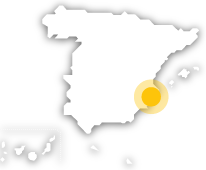Located between the capes of San Antonio and de la Nao, Jávea is one of the most important tourist destinations on the Alicante Costa Blanca.
Its old quarter, which is only two kilometres away from the coastline, hides beautiful examples of local architecture, as well as famous monuments, such as the Church of San Bartolomé, in the town's heart.One of the main attractions of this town in Alicante is its extensive coastline. An impressive 25 kilometres of coastline, where you can enjoy a swim and practice a wide variety of water sports.
This town on the Alicante Costa Blanca shows its most touristic side in the port area. In addition to a wide range of accommodation, restaurants and leisure options, the port offers everything from water sports, such as sailing and windsurfing, to boat trips to Denia.El Arenal beach is one of the most emblematic beaches on the Jávea coastline. In this place, next to the Canal de la Fontana, stands the Parador de Turismo “Costa Blanca”, in a privileged enclave just a few metres from the beach.One of the most beautiful stretches of coastline can be found between the islands of Portixol and Descubridor. Its transparent waters and excellent seabed make it an ideal setting for diving.This underwater activity is also popular in Cala Granadella, another of the most popular places on the coast of Jávea.
The city
Situated on a plain at the foot of the Montgó massif, the historic centre of Jávea developed inland around the fortress church of San Bartolomé, a beautiful example of Isabelline Gothic style that emerged as a defence against pirate attacks.Visitors are drawn to the many examples of typical architecture on the old quarter, which are present in elements such as the bars on the windows on houses and the lintels made of “tosca” stone.Another must-see attraction on a tour of the city centre is a visit to the Archaeological and Ethnographic Museum, where you can learn about the town's past.Meanwhile, in the port area it is worth visiting the Church of Our Lady of Loreto, which resembles the keel of a ship.
Gastronomy, festivities and the surrounding area
Jávea bases its gastronomy on foods typical of the Mediterranean diet. As is common in other Valencian towns, the star product is rice. Paella is perhaps the best-known dish, but here it is served with beans and turnips or baked in the oven. Local fish is served on the table stewed, fried or in broth. Garlic and oil are the basis of the emblematic ali-oli sauce, which accompanies numerous dishes.Almonds, raisins, figs and oranges are the most typical fruits of this area and are normally included in Alicante desserts. Almond cakes, nougats and ice creams are some of the most appetizing. Jávea also offers wines from the Alicante Designation of Origin, such as misteleta (sweet wine) and horchata (tiger nut drink).As for the festive calendar of Jávea, this town celebrates the festivities of the Virgen del Carmen on July 16. A few days later, on the penultimate weekend of the month, the Festival of Moors and Christians is held.The surroundings of Jávea offer numerous possibilities. The lighthouses and the Cabo de San Antonio Marine Nature Reserve are excellent excursions for nature lovers. The visit can continue in the Montgó Natural Park, a place where the mountain profiles plunge into the Mediterranean, creating suggestive cliffs.It is also possible to visit attractive towns, such as Denia, the capital of the Marina Alta. On the other side of Cape Nao lies Teulada. Next to the Peñón de Ifach Natural Park, you will find Calpe, a harmonious city that has managed to combine the preservation of its monumental heritage with tourist infrastructures.Another interesting monumental town on the Costa Blanca is Villajoyosa, capital of the Marina Baja. And crossing the Sierra de Aitana, the northern interior offers us a tour of Cocentaina, an important medieval centre of houses adorned with ceramics and Arab-style streets.Alicante's mountains also allow visitors to explore the Carrascal de la Font Roja Natural Park, with rugged terrain on the north side, and the town of Alcoy/Alcoi, in whose medieval quarter the “Moors and Christians” festival is revived every year, declared of International Tourist Interest.





